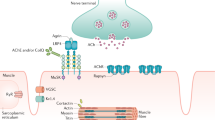Summary
Myasthenia gravis is a disorder of autoimmunity in which neuromuscular transmission is impaired by autoantibodies to the acetylcholine receptor (AChR). There is evidence for more than one form of the disorder with differing genetic susceptibilities. The aetiology is unknown, but thymic involvement is suggested by abnormal histology and by the beneficial response of the disorder to thymectomy in more than two-thirds of patients. Thymectomy is indicated in most patients unless the symptoms are minimal or are confined to the extraocular muscles alone, or the patient is elderly. Thymectomy alone results in remission in about one-third of patients, but, in addition, most patients require symptomatic anticholinesterase drugs to prolong the action of acetylcholine at the muscle end-plate. Overdosage of these drugs can also cause weakness.
Immunosuppression with corticosteroids or azathioprine may also improve myasthenia; at present, these drugs are used mainly in patients who do not respond to thymectomy or in those patients considered unsuitable for operation. Plasma exchange can cause a rapid, though temporary, involvement in myasthenia, but it probably has no long term place in its treatment. Future therapy will probably involve specific immunotherapy, such as anti-idiotype antibodies.
Similar content being viewed by others
References
Almon, R.R.; Andrew, C.G. and Appel, S.H.: Serum globulin in myasthenia gravis: Inhibition of alpha-bungarotoxin binding to acetylcholine receptors. Science 186: 55–57 (1974).
Buckingham, J.M.; Howard, Jr. F.M.; Bernatz, P.E. et al.: The value of thymectomy in myasthenia gravis. A computerassisted matched study. Annals of Surgery 184: 453–458 (1976).
Chang, C.E. and Lee, C.Y.: Archives Internationales de Pharmacodynamie et de Therapie 144: 241 (1962).
Compston, D.A.; Vincent, A.; Newson-Davis, J. and Batchelor, J.R.: Clinical, pathological HLA antigen and immunological evidence for disease heterogeneity in myasthenia gravis. Brain 103: 579–601 (1980).
Donat, J.F.; Donat, J.R. and Lennon, V.A.: Exchange transfusion in neonatal myasthenia gravis. Neurology 31: 911–912 (1981).
Engel, A.G.; Lambert, E.H. and Santa, T.: Study of long-term anticholinesterase therapy. Neurology 23: 1273–1281 (1973).
Garlep, M.J.; Dawkins, R.L. and Christiansen, F.T.: HLA antigens and acetylcholine receptor antibodies in penicillamine induced myasthenia gravis. British Medical Journal 286: 338–341 (1983).
Kennedy, F.S. and Moersch, F.P.: Canadian Medical Association Journal 37: 216 (1937).
Lindstrom, J.M.; Seybold, M.E.; Lennon, V.A. et al.: Antibody to acetylcholine receptor in myasthenia gravis. Prevalence, clinical correlates and diagnostic value. Neurology 26: 1054–1059 (1976).
Mertens, H.G.; Hertel, G.; Reuther, P. and Ricker, K.: Effect of immunosuppressive drugs (azathioprine). Annals of the New York Academy of Sciences 377: 691–699 (1981).
Olanow, C.W.; Wechsler, A.S. and Roses, A.D.: A prospective study of thymectomy and serum acetylcholine receptor antibodies in myasthenia gravis. Annals of Surgery 196: 113–121 (1982).
Oosterhuis, H.J.: in Satoyoshi (Ed.) Myasthenia Gravis: Pathogenesis and Treatment (University of Tokyo Press, Tokyo 1981).
Pirofsky, B.: The effect of anti-thymocyte antiserum in progressive myasthenia gravis. Annals of the New York Academy of Sciences 377: 779–785 (1981).
Rowland, L.P.: Controversies about the treatment of myasthenis gravis. Journal of Neurology, Neurosurgery and Psychiatry 43: 644–659 (1980).
Rowland, L.P.; Hoefer, P.R.A.; Aranow, H.J.R. and Merritt, H.H.: Fatalities in myasthenia gravis. A review of 39 cases with 26 autopsies. Neurology 6: 307–326 (1956).
Scadding, G.K.; Vincent, A.; Newson-Davis, J. and Henry, K.: Acetylcholine receptor synthesis by thymic lymphocytes: Correlation with thymic histology. Neurology 31: 935–943 (1981).
Simpson, J.A.: Myasthenia gravis: A new hypothesis. Scottish Medical Journal 5: 419–436 (1960).
Smithers, D.W.: Tumours of the thyroid gland in relation to some general concepts of neoplasia. J. Facult. Radiol. 10: 3–16 (1959).
Symington, G.R.; Mackay, I.R. and Lambert, R.P.: Cancer and teratogenesis. Infrequent occurrence after medical use of immunosuppressive drugs. Australia and New Zealand Journal of Medicine 7: 368–372 (1977).
Author information
Authors and Affiliations
Rights and permissions
About this article
Cite this article
Havard, C.W.H., Scadding, G.K. Myasthenia Gravis. Drugs 26, 174–184 (1983). https://doi.org/10.2165/00003495-198326020-00004
Published:
Issue Date:
DOI: https://doi.org/10.2165/00003495-198326020-00004




